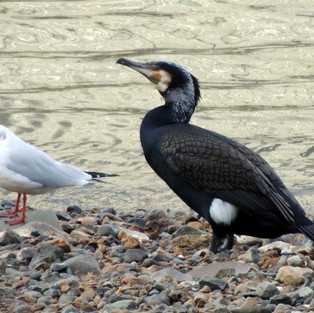Great cormorant (Phalacrocorax carbo)
- J Gill
- Oct 26, 2020
- 3 min read
Updated: Jan 23, 2021
Here is yet another bird that looks the same as the double-crested cormorants we have at home, but as usual, the scientific name is different, so it evidently is not the same bird. They do look really similar, though. The great cormorant is not one of the many birds I've seen at or around St James Park. There are actually a fair number of birds I've seen around where I live as well, but you usually don't see them all congregated together at the same time like at the park. In any case, I've always thought of the cormorant as one of the coolest birds around. They look fierce and ancient, and they often appear intimidating when they're on a perch with their wings stretched out--they are actually drying them, but it looks like they're trying open up their cloak to swallow you inside or something else spooky. As far as I'm concerned, they should be every bit as eligible to be associated with Halloween as black cats and witches! See below, and tell me if you agree :)
January 18, 2021: I thought I was seeing a different species of cormorant or an old one or young one or a partially leucistic one. I didn't really know for sure. I had been out for a walk and saw a couple cormorants with white on them, and I was so excited. I had been recovering from an ankle injury, and it was my first real walk to see if I was ready yet to go longer distances, so I chanced a shorter walk than usual. It ended up being a bit longer than intended because I came back to my flat to grab my camera and go out again. By the time I got back, most of the 20 or so cormorants hanging out there had already left. Just my luck! I figured it was hopeless, but then I saw that the 2 cormorants left both had the white on them! I couldn't believe it! I thought it was an anomaly. But when I came back home, ankle intact and all, thankfully, I did some research to see what they might be, and it turns out they are the same cormorants but in breeding plumage. I didn't know that they have breeding plumage. I've never seen cormorants at home develop them, but I also only know of one place to see them in my city, and I don't go there often, so perhaps they do this, and I've never seen it before. Even though it wasn't a new species, it was still exciting to be able to see this change in their plumage. Back home, we don't really start seeing and feeling spring weather until late March or early April, and that when migrating birds start venturing back, but I imagine since the weather is milder here, I'll see breeding happen sooner and birds starting to turn around now and in the near future. For now, here are some of the breeding plumage photos. I think you can click on them to see the whole photo as they get a bit cut off here. You might recognise the black-headed gull in the photos as well, and I've noticed some of them are starting to develop their breeding plumage as well, but I'll share those in their entry later.




















Comments